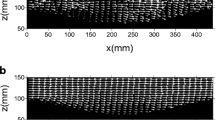Abstract
We present detailed numerical results for two-dimensional viscous air–water flow of a non-linear progressive water wave when the speed of the opposing wind varies from zero to 1.5 times the wave phase speed. It is revealed that at any speed of the opposing wind there exist two rotating airflows, one anti-clockwise above the wave peak and one clockwise above the wave trough. These rotating airflows form a buffer layer between the main stream of the opposing wind and the wave surface. The thickness of the buffer layer decreases and the strength of rotation increases as the wind speed increases. The profile of the average \(x\)-component of velocity reveals that the water wave behaves as a solid surface producing larger wind stress compared to the following-wind case.















Similar content being viewed by others
References
Cohen JE (1997) Theory of turbulent wind over fast and slow waves. PhD thesis, University of Cambridge, Cambridge
Crapper GD (1984) Introduction to water wave Ellis Horwood. Wiley, New York 224 pp
Dean RG, Dalrymple RA (1984) Water Wave Mechanics for Engineers and Scientists. Prentice-Hall Inc., Upper Saddle River 353 pp
Donelan MA (1990) Air–sea interaction. Sea: Ocean Eng Sci 9:239–292
Donelan MA (1999) Wind-induced growth and attenuation of laboratory waves. In: Sajjadi SG, Thomas NH, Hunt JCR (eds) Wind-over-wave coupling, perspective and prospects. Clarendon Press, Oxford 356 pp
Fenton J (1985) A fifth-order Stokes theory for steady waves. Waterw Port Coast Ocean Eng 111(2):216–234
Grare L, Peirson WL, Branger H, Walker JW, Giovanangeli JP, Makin V (2013) Growth and dissipation of wind-forced, deep-water waves. J Fluid Mech 722:5–50
Harris JA, Fulton I, Street RL (1995) Decay of waves in an adverse wind. In: Proceedings of the sixth Asian congress of fluid mechanics, May 22–26, Singapore
Hasselmann D, Bosenberg J (1991) Field measurements of wave-induced pressure over wind-sea and swell. J Fluid Mech 230:391–428
Kalvig SM, Manger E, Kverneland R (2013) Structure of air flow separation over wind wave crests method for wave driven wind simulation with CFD. Energy Procedia 35:148–156
Lamb H (1916) Hydrodynamics. Cambridge University Press, Cambridge 708 pp
Li PY, Xu D, Taylor PA (2000) Numerical modelling of turbulent airflow over water waves. Bound-Layer Meteorol 95:397–425
Mastenbroek C (1996) Wind wave interaction. PhD thesis, Delft Technical University
Milne-Thomson LM (1994) Theoretical hydrodynamics. Dover Publications Inc, New York 743 pp
Mitsuyasu H, Yoshida Y (2005) Air–sea interactions under the existence of opposing swell. J Oceanogr 61:141–154
Peirson WL, Garcia AW, Pells SE (2003) Water wave attenuation due to opposing wind. J Fluid Mech 487:345–365
Snyder RL, Dobson FW, Elliott JA, Long RB (1981) Array measurements of atmospheric pressure fluctuations above surface gravity waves. J Fluid Mech 102:1–59
Sullivan PP, Edson JB, Hristov T, McWilliams JC (2008) Large-Eddy simulations and observations of atmospheric marine boundary layers above non-equilibrium surface waves. Atmos Sci 65:1225–1245
Wen X (2012) The analytical expression for the mass flux in the wet/dry areas method. ISRN Applied Mathematics. 2012: Article ID 451693, 15 pages, doi:10.5402/2012/451693
Wen X (2013) Wet/dry areas method for interfacial (free surface) flows. J Num Methods Fluids 71(3):316–338
Wen X, Mobbs (2014) Numerical simulations of laminar air–water flow of a non-linear progressive wave at low wind speed. Bound-Layer Meteorol 150:381–398
Young IR, Sobey RJ (1985) Measurements of the wind-wave energy flux in an opposing wind. J Fluid Mech 151:427–442
Acknowledgments
We would like to thank the constructive comments of the reviewers.
Author information
Authors and Affiliations
Corresponding author
Rights and permissions
About this article
Cite this article
Wen, X., Mobbs, S. Numerical Simulations of Air–Water Flow of a Non-linear Progressive Wave in an Opposing Wind. Boundary-Layer Meteorol 156, 91–112 (2015). https://doi.org/10.1007/s10546-015-0012-1
Received:
Accepted:
Published:
Issue Date:
DOI: https://doi.org/10.1007/s10546-015-0012-1



